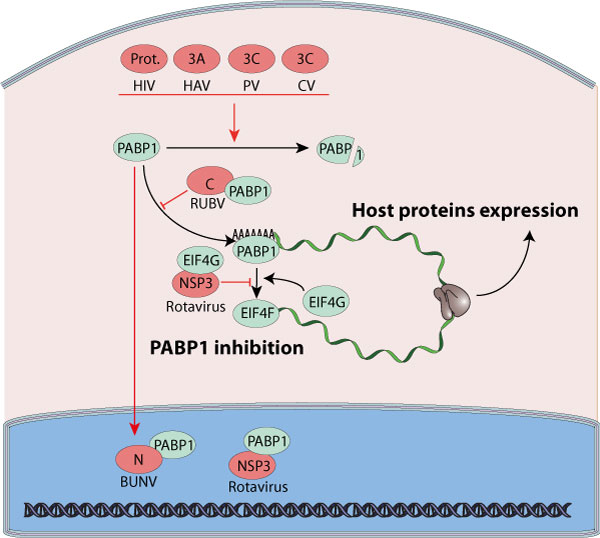
Numerous viruses interfere with PABPC1 function in translation initiation. Inhibiting host translation eventually leads to shutoff of host proteins expression and gives viruses transcripts a competitive edge for access to the cellular translation machinery. Preventing the expression of host proteins is also a strategy to counteract the antiviral response.
Viral inhibition can be achieved either by cleaving PABPC1 with virally encoded proteases, evicting it from translation initiation complexes or relocalizing it to the nucleus
 .
.
Viruses inhibiting PABPC1:
| Family | Virus | Viral protein | PABPC1 inhibition strategy | references |
| Retroviridae | HIV-1 | Protease | PABPC1 cleavage |


|
| Picornaviridae | Poliovirus | Protease 3C | PABPC1 cleavage |

|
| Hepatitis A virus | Protease 3C | PABPC1 cleavage |

|
|
| coxsackie virus | Protease 2A, protease 3C | PABPC1 cleavage |

|
|
| Foot-and-mouth disease virus | ?Leader protease | PABPC1 cleavage |

|
|
| Caliciviridae | MD145-12 | Protease 3C | PABPC1 cleavage |

|
| feline calicivirus | Protease 3C | PABPC1 cleavage |

|
|
| Reoviridae | Rotavirus | NSP3 | Interacts with EIF4G and evicts PABC1 from initiation complexes. Nuclear relocalization of PABC1 |


|
| Bunyaviridae | Bunyamwera virus | Nucleoprotein | Nuclear relocalization of PABC1 |

|
| Togaviridae | Rubella virus | Capsid protein | PABC1 sequestration |

|

